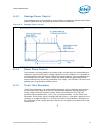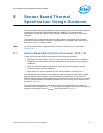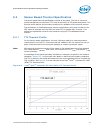
Thermal/Mechanical Specifications and Design Guidelines 65
Sensor Based Thermal Specification Design Guidance
8 Sensor Based Thermal
Specification Design Guidance
The sensor based thermal specification presents opportunities for the system designer
to optimize the acoustics and simplify thermal validation. The sensor based
specification utilizes the Digital Thermal Sensor information accessed via the PECI
interface.
This chapter will review thermal solution design options, fan speed control design
guidance & implementation options and suggestions on validation both with the TTV
and the live die in a shipping system.
Note: A new fan speed control implementation scheme is called DTS 1.1 introduced in
Section 8.4.1.
8.1 Sensor Based Specification Overview (DTS 1.0)
Create a thermal specification that meets the following requirements:
• Use Digital Thermal Sensor (DTS) for real-time thermal specification compliance.
• Single point of reference for thermal specification compliance over all operating
conditions.
• Does not required measuring processor power and case temperature during
functional system thermal validation.
• Opportunity for acoustic benefits for DTS values between T
CONTROL
and -1.
Thermal specifications based on the processor case temperature have some notable
gaps to optimal acoustic design. When the ambient temperature is less than the
maximum design point, the fan speed control system (FSC) will over cool the processor.
The FSC has no feedback mechanism to detect this over cooling, this is shown in the
top half of Figure 8-1.
The sensor based specification will allow the FSC to be operated at the maximum
allowable silicon temperature or T
J
for the measured ambient. This will provide optimal
acoustics for operation above T
CONTROL
. See lower half of Figure 8-1.


















